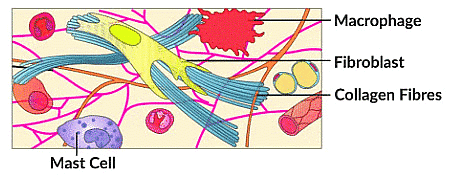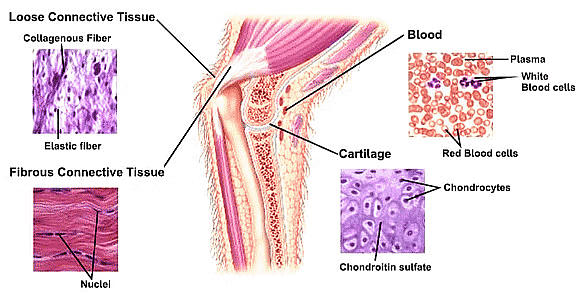Not in NCERT)"
| Table of contents |

|
| Connective Tissue |

|
| Loose Connective Tissue |

|
| Dense Connective Tissue |

|
| Specialized Connective Tissue |

|
Connective Tissue
In single-celled organisms, one cell handles essential functions like digestion, respiration, and reproduction. In multicellular organisms, different groups of cells efficiently carry out these functions. Multicellular organisms, such as Hydra, consist of various cell types, with thousands in each category. Cells of the same type, along with intercellular communication, specialize to perform distinct functions in multicellular organisms, forming what is known as tissue.
All complex animals are primarily composed of four fundamental types of tissues. These tissues are organized in specific arrangements to create organs like the stomach, lungs, heart, or kidneys. When multiple organs work together physically and/or chemically for a common purpose, they form organ systems such as the digestive or respiratory systems. Cells, tissues, organs, and organ systems collaborate to enable division of labor, supporting the body's overall survival.
Functions of Connective Tissue
- Connective tissue serves to connect biological components like bones and muscles or to support tissues such as muscles, tendons, and organs in their proper locations within the body.
- It reinforces joints, providing strength and support to the connections between bones.
- Connective tissue facilitates the transport of nutrients and metabolic waste from the bloodstream to the tissues it surrounds.
- Comprised of proteins like collagen, elastin, and intercellular fluid, connective tissue can vary in form from thin sheets to fibrous ropes, maintaining a relatively consistent structure throughout the body.
Animal Tissues - Cell structure varies based on function, resulting in different types of tissues that can be broadly categorized into four groups:
- Epithelial
- Connective
- Muscular
- Neural
Connective tissues are abundant and widely spread throughout the bodies of complex animals. They are named so because they provide connections and support to other tissues and organs within the extracellular matrix. These tissues encompass soft types as well as specialized forms like cartilage, bone, fat, and blood. In all connective tissues except blood, cells secrete structural proteins such as collagen or elastin. These fibers contribute to the tissue's strength, elasticity, and flexibility. Additionally, cells release modified polysaccharides which accumulate between cells and fibers, acting as a matrix or ground substance.
There are three primary types of connective tissues:
- Loose connective tissue
- Dense connective tissue
- Specialized connective tissue
Loose Connective Tissue
Loose connective tissue consists of cells and fibers dispersed within a semi-fluid ground substance, like areolar tissue located beneath the skin layer. It often acts as a scaffold for the epithelium. Comprised of fibroblasts (cells producing and secreting fibers), macrophages, and mast cells, this tissue includes adipose tissue, primarily found beneath the skin, specialized in fat storage by converting excess nutrients into lipids for storage.

- Collagen fibers provide strength and structural support to other tissues and organs, acting as a cushion.
- Elastic fibers impart elasticity to tissues and organs.
- It facilitates blood supply to adjacent epithelial tissue.
- It promptly responds to epithelial damage or antigen interaction.
- Adipose tissue aids in lipid storage.
Functions of Loose Tissues
- Collagen fibers provide strength and support to various tissues and organs in the body.
- They also act as a cushioning material, absorbing shocks and impacts.
- Elastic fibers contribute elasticity to tissues and organs, allowing them to stretch and recoil.
- Connective tissues ensure a proper blood supply to the surrounding epithelial tissue.
- They play a crucial role in responding promptly to any damage or interaction with antigens.
- Adipose tissue assists in storing lipids and providing insulation.
Dense Connective Tissue
The dense connective tissues are densely packed with fibers and fibroblasts. The fibers are arranged in either a regular or irregular pattern, giving rise to dense regular and dense irregular tissues respectively.
In dense regular connective tissues, collagen fibers are aligned in rows between parallel bundles. Tendons and ligaments are examples of such tissues, connecting muscles to bones and bones to other bones, respectively.
Dense irregular connective tissue contains fibroblasts and collagen fibers oriented in multiple directions, providing strength and support in various planes.
Functions of Dense Connective Tissue
- Dense connective tissue primarily serves to protect the body from mechanical stresses.
- Irregular dense connective tissue can withstand forces from multiple directions, while regular dense connective tissue is resistant to stress in one specific direction due to the parallel orientation of collagen fibers.
- Dense regular collagenous connective tissue, found in ligaments and capsules, offers structural support to organs.
- Regular elastic dense connective tissue imparts elastic properties, allowing stretching and bending in organs like the skin, providing flexibility and protection against injuries.
- This tissue, present in the skin's dermis, forms a barrier against pathogens, enhancing the body's immune defense mechanisms.
- Thick regular elastic connective tissue in large blood vessels aids in maintaining blood flow by accommodating pressure changes during the cardiac cycle.
- The main role of dense connective tissue is to safeguard the body against mechanical stress. Irregular dense connective tissue can counterbalance multidirectional pressures, while regular dense connective tissue can only resist stress in one direction due to the parallel orientation of its collagen fibers.
- Dense regular collagenous connective tissue is highly resistant to one-way traction. It is predominantly found in ligaments and capsules, providing structural support to the organs it surrounds.
- Regular elastic dense connective tissue, as the name suggests, imparts elastic properties to the organ it supports, enabling it to stretch and flex to a certain extent when combined with rigid components.
- This type of tissue is located in the dermis of the skin, acting as a secondary defense against injuries. It contributes to the skin's flexibility and, with various cell types present, assists in protecting against pathogens, forming a barrier that shields vital organs.
- Thick regular elastic connective tissue in major blood arteries allows the buildup of tension in the vessel wall during cardiac systolic ejection. The release of this tension maintains vascular blood flow during the diastole phase.
Specialized Connective Tissue
- Specialized connective tissues, such as cartilage, bones, and blood, exhibit distinct characteristics. Cartilage possesses a solid, malleable intercellular substance that resists compression. Chondrocytes, its cells, are housed in small cavities within the matrix they produce. In adults, many cartilages from vertebrate embryos are replaced by bones, although cartilage persists in areas like the nose tip, outer ear joints, and between spinal bones.
- Bone, with its hard, non-pliable ground substance rich in calcium salts and collagen fibers, provides structural support to the body. It supports and protects soft tissues and organs and houses bone cells (osteocytes) in lacunae. Long limb bones bear weight and collaborate with skeletal muscles for movement. Certain bones produce blood cells in their marrow.
- Blood, a connective fluid, consists of plasma, red and white blood cells, and platelets. It acts as the primary circulating medium for transporting various substances throughout the body.
Specialized Connective Tissue Functions

- Connective and support tissues serve the purpose of filling the body.
- Adipose tissue primarily consists of lipids and/or fats.
- Cartilaginous connective tissue contains elastic cartilage that cushions between bones.
- Woven Bone is made up of mineralized tissues known as bone.
- The lymphatic system connects glands and aids in the body's defense mechanisms.
- Blood is a connective tissue comprising blood cells.
|
150 videos|399 docs|136 tests
|
FAQs on Not in NCERT)"
| 1. What is connective tissue? |  |
| 2. What are the functions of connective tissue? |  |
| 3. How many types of connective tissue are there? |  |
| 4. What are some common disorders related to connective tissue? |  |
| 5. How can connective tissue disorders be treated? |  |
















